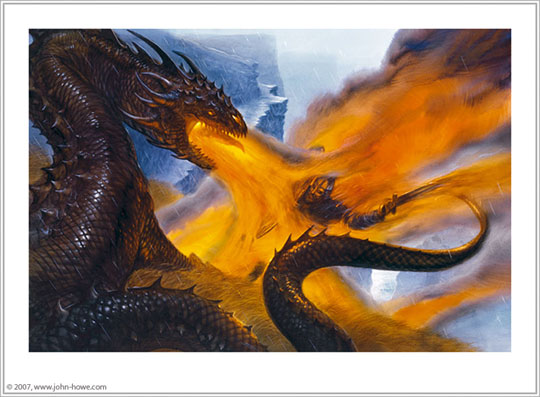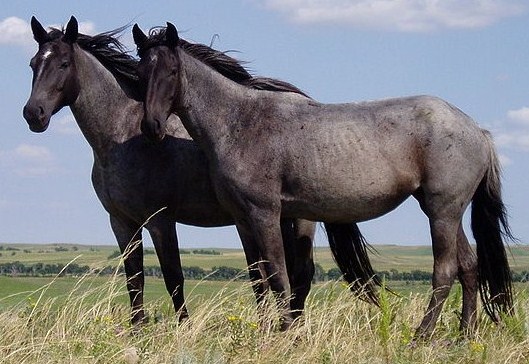Translation
Recordings
When Words Flash, Sharp as Swords
A Matter of Succession
Closing
Back To Top
Abstract
Thanks to a team effort, Beowulf and Wiglaf bring down the dragon.
Back To Top
Translation
"Then the ravager of a people for a third time,
the terrible fire dragon intent on a hostile deed,
rushed on that renowned one when for him the opportunity
permitted, hot and battle fierce. All of his neck was
clasped by sharp tusks; he was made to become bloody
with ichor, gore in waves surged out.
Then, as I have heard, the soldier by his side showed
known courage for his liege lord,
strength and boldness, as was inborn.
He worked not upon the head, but the hand of that daring
man was burned, when he his kin helped by striking
a little lower at the strife-stranger with blade full
of cunning, so that the decorated sword, gleaming and
gold-adorned, stuck in the beast's stomach so that the
fire began to abate afterwards. Then once more the king
himself wielded his wit, brandished a hip-blade, bitter
and battle-sharp, that he wore on his byrnie;
the protector of the Weders cleaved the dragon in its
middle."
(Beowulf ll.2688-2705)
Back To Top
Recordings
Old English:
{Forthcoming}
Modern English:
{Forthcoming}
Back To Top
When Words Flash, Sharp as Swords
The words here are definitely meant to mimic the flashing of blades. The exact words are different, of course, being translated, but the description of the duo's weapons and their working is preserved.
The descriptive phrases "sword full of cunning, so that the decorated sword,/gleaming and gold-adorned" ("þæt ðæt sweord gedēaf,/
fāh ond fǣted" (ll.2700-2701)) and "brandished a hip-blade,/bitter and battle-sharp," ("wællseaxe gebrǣd/biter ond beaduscearp" (ll.2703-2704)) in both Englishes still give a vivid image of steel being swung or stabbing, all the while glittering with either jewels or fatal intent.
Such description and rhetorical use of language is effective here because it brings listeners/readers into the action of the poem while also reminding them of the extreme danger of the dragon. After all, the gleam of Wiglaf's sword is likely as much due to whatever natural light is available as it is to the dragon's fire illuminating it; and Beowulf's "bitter and battle-sharp" dagger, drawn with wit, reminds us of the kind of cunning required to slay something so ancient, deadly, and tricky in its own right.
Back To Top
A Matter of Succession
If there was ever a history of Wiglaf penned by a monk or sung by a bard, and if that history involved a successor, it would not be surprising if Wiglaf's successor helped him win his final battle.
Kingship is something that needs to be continuous, lest a contest for the throne result in the destruction of a house, much like the case of Haethcyn and Herebeald. And there is no better way to pass on kingship than to slay a dragon with your successor.
In fact, if the line of kings is regarded as a kind of chain, Wiglaf's selfless stabbing of the dragon below its armored head is exactly where his link connects to that of Beowulf as the poem's hero rallies and defeats the dragon, drawing his own link on the chain of kingship (and, *spoilers* his life */spoilers*) to a close.
But Neil Gaiman wasn't far from the mark when he has Wiglaf succeed Beowulf, for although it may be short lived, Wiglaf's succession of Beowulf is exactly what this team effort solidifies.
Back To Top
Closing
Next week, this blog will be on break so that what's here can be tidied up, recordings can be posted, and a new page can be launched. But, in the meantime, I'll be updating my other blog every day of the week, so check it out at http://glarkly.blogspot.ca!
Back To Top







